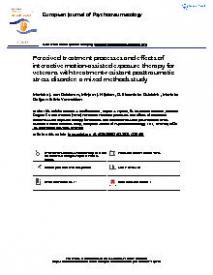Perceived treatment processes and effects of interactive motion-assisted exposure therapy for veterans with treatment-resistant posttraumatic stress disorder : a mixed methods study
Background: A novel intervention, Multi-modular motion-assisted memory desensitization and reconsolidation (3MDR), aims to reduce avoidance and improve engagement for patients with posttraumatic stress disorder (PTSD) who did not sufficiently respond to previous treatments. It has been found to effectively reduce PTSD symptoms for veterans with treatment-resistant PTSD. Symptomatic measures alone might not capture all treatment effects, and addition of qualitative outcomes may provide deeper understanding of treatment processes and treatment-induced changes.
Objective: To study the perspectives of veterans with treatment-resistant PTSD on 3MDR treatment processes and effects and explore the relation of their experiences to PTSD symptom improvement.
Method: A convergent parallel mixed methods design was applied. For the qualitative part, open-ended question interviews were conducted until data saturation was reached (N = 10). Thematic analysis, rooted in grounded theory, was performed. Quantitative data included pre- to posttreatment responder status based on a structured clinical interview for PTSD.
Results: Treatment processes endorsed by the veterans were engaging, regulating distress, feeling supported, facing traumatic memories, allowing emotions, associating, and disengaging from trauma. In terms of effects, veterans reported positive changes following 3MDR, including openness, new learning, self-understanding, closure, and reintegration. High comparability across themes was observed for responders and non-responders, except for the themes closure and reintegration, which were reported more often or more in depth by
responders.
Conclusions: Veterans indicated 3MDR treatment processes that complied with its aims of breaking through avoidance and increasing engagement, thereby facilitating traumatic memory retrieval and processing. However, this did not necessarily translate into PTSD symptom improvement for all veterans. Walking towards trauma-related pictures was highlighted as unique component of 3MDR and connected to specific treatment processes and effects. Positive changes following 3MDR were experienced outside the domain of PTSD symptom improvement, implicating that 3MDR may beneficially impact veterans beyond symptom changes alone.
In: European Journal of Psychotraumatology ; ISSN: 2000-8066 | 11 | 1 | 1829400
https://doi.org/10.1080/20008198.2020.1829400


